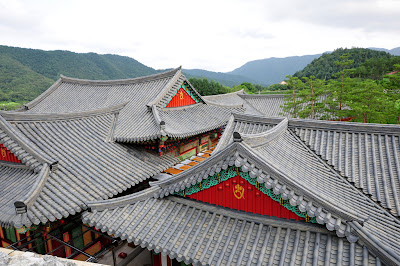Will it be correct if I understand the real
existence of the Buddha that you have
declared as this Reward Body Buddha?
Taking this opportunity, could you please
explain the Buddha Body(佛身) to us more in
detail?
The theory of the Buddha Body(佛身論) is an
important part that is the essence of the essence
and the highest level in the doctrine of Buddhism.
The theory of the Three Bodies of the Buddha
appears in sutras and treaties, but they are abstract
and incorrect. It is impossible to realize the theory
of the Buddha Body correctly unless one reaches
the level of a Buddha; especially, scholars will be
faced with a great limitation to grasp theoretically.
Yongsan Buddhism has put forward correct and
concrete theory of the Three Bodies on the basis
of experiences of the Great Monks.
The three forms of the Bodies that the Buddha
has are the Dharma Body Buddha(法身佛), the
Reward Body Buddha (報身佛), and the
Transformation Body Buddhas(化身佛).
The Dharma Body Buddha is the formless
universal light of a Buddha who has become one
with the whole Dharma realm of the universe. As
the Dharma Body Buddha has the concept of
covering the whole Dharma realm beyond the
universe, his light is different at its level from that
of self nature that exists beyond the phenomenal
world. It is the original body of a Buddha Body,
and a Real Buddha. This Dharma Body Buddha
exists, transcending sense and form. So he does
not think nor discriminate. He always shines over
the Dharma realm of the universe. What is more,
there is no place where this light does not shine.
Therefore, there is no place where he does not
abide,
A Reward Body Buddha is an original Buddha
with a form, whose existence relies on the
Dharma Body Buddha. A Reward Body Buddha
is a Body made of light and a Body with
blessings that a Buddha Body of a Buddha and
his four spiritual bodies are completely put
together. A Reward Body Buddha is the central
Buddha who possesses 32 bodily signs and 80
marks, who thinks and judges as a body with
human character, and who saves sentient beings.
As a Reward Body Buddha is made of a billion
kinds of transparent and lucid Immeasurable
Light, he does not become extinct through all
eternity, and can display universal awesome
spiritual powers, freely entering the utmost
samadhi, namely samadhi of great quiescence.
The Buddha on whom we must rely is no other
than this Reward Body Buddha.
The Transformation Body Buddhas who are the
third Bodies mean the Buddhas who manifest in
thousands, millions, and billions of Bodies to
save sentient beings. A Reward Body Buddha can
manifest countless numbers of Transformation
Body Buddhas as necessary. These
Transformation Body Buddhas are independent
Bodies with human character, and perform
activities of saving sentient beings.
The view of the Buddha Body asserted by
Tibetan Buddhism, and that asserted by Seon
Buddhism are both very mistaken views. Tibetan
Buddhism understands the pure illusory body
that a mind-made body (意生身) of a
practitioner has created by receiving the light of
original nature of the universe (淨光明, vimala-
prabhasa of jing guang ming) as a reward body, but
this is a relatively low-grade body with a limited
lifespan that cannot daringly be compared with
the Reward Body in the theory of the Buddha
Body. There is more than a world of difference
between the two. Also, Seon Buddhism is looking
for the three bodies of the Buddha in Mind (self
nature, 自性三身), but I definitely tell you that this
is also a false speech, saying without any
knowledge of the aspect of the Buddha. It is
clearly stated in 'the Parable' in the Lotus Sutra.
source /An Interview with a Reporter on the Thoughts of Yongsan Buddhism
publication/Hyonjisa, Yongsan Buddhism








